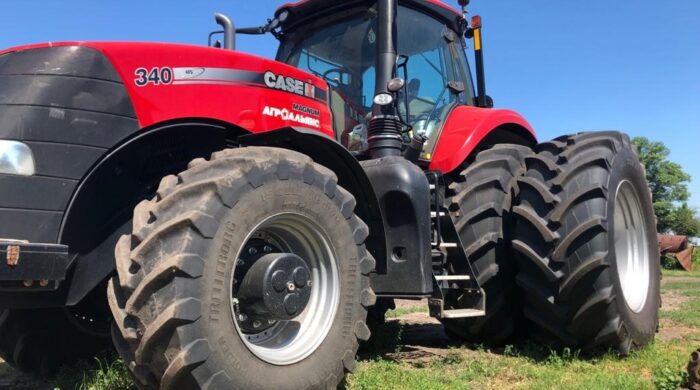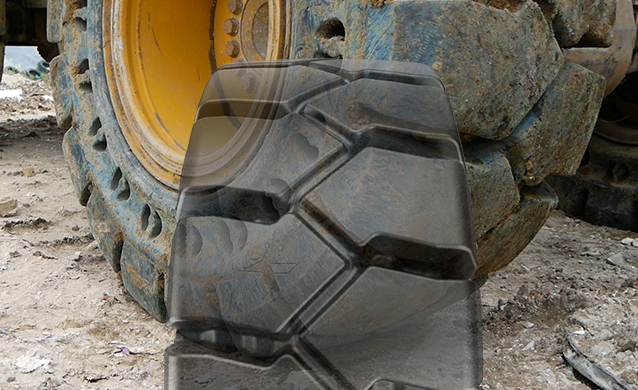
MAXAM TIRE ON OPTIMIZED TRACTION IN AG APPLICATIONS
Understanding why it is important for AG Tires to have a small slip percentage to optimize traction, recommendations for % of slip for MFWD & 4WD Tractors, and how tire physics and slip ratios differ from tracks
As with all challenges in the Ag industry, every operation is a compromise between the equipment, the crop, the implementation, and operational requirements to complete the job. In farming operations using either a 2WD, MFWD, or 4WD Tractor, it is not recommended to use 100% of the rated axle power to pull your implement. If you use 100% of your power to pull an implement or load below 5 mph the farmer or grower runs the risk of over-straining the tractor engine and drivetrain systems causing premature wear of your components. This will also affect your tire life as well as possibly increase soil compaction due to the additional strain. The goal is to achieve the optimal transmission of power to each axle allowing for a percentage of tire slip to achieve the highest level of power and traction based on the load carried or pulled, road or field usage, and the required working speed to get the job done.
General Rules Related to Wheel & Tire Slippage:
- Too Much Slip = Loss of 25% to 30% of your transmitted power = more fuel consumed + increased tire wear with greater engine component use
- Too Little Slip = Too much weight (wheel weights, suitcase weight, or liquid ballast) being pulled = Loss of efficiency + increased fuel consumption + increased soil compaction
- Zero (0) Slip = Only when “Roading” a tractor do you want the engine slip meter to drop to 0%.
Optimal Tractor Slip Percentage (%) Based on Tractor Type & Ground Conditions:
Tractor Type:
- 2WD Tractors = from 10% up to 15% Slip Rate
- MFWD Tractors = from 8% up to 12% Slip Rate
- 4WD Tractors = from 8% up to 10% Slip Rate
Ground Working Conditions:
- Hard Soils: Less Slippage for Maximum Engine Efficiency
- Soft Soils: More Slippage for Maximum Engine Efficiency
- Hard Surface Roads: 0% Slippage for Maximum Engine efficiency
Tire or wheel slippage is a calculation that the tractor drive system measures by assessing the number of revolutions based on the tire circumference, power, time, and the actual distance traveled.
In essence, if you travel 200 feet and your actual tire revolution (circumference) distance traveled is equal to 220 feet traveled your Wheel / Tire Slip rate = 10%
Example: 220 Tire Circumference Ft Traveled / 200 Actual Distance Traveled Ft = 10% Slip Rate
Factors that Can Impact Wheel / Tire Slippage:
- Gear ratio considerations for MFWD Tractors: Ensure tires selected have the appropriate tire diameter Rear to front (RCI) to maintain the 5 to 1 engine gear ratio required for MFWD type tractors
- Employ the optimal tractor speed for any fieldwork @ +5 mph to efficiently maximize engine power and transmission
- Set the Correct Tire Cold Inflation Pressure based on the actual axle Load (tire weight) and the number of tires being employed by tire size.
- Employ the best weight distribution possible by adjusting the axle load ballast using suitcase weights, wheel-mounted weights, or tire liquid ballast (not recommended) for the pulled or towed implement.
Recommended Ag Industry Tractor Weight Distribution by Axle Load:
- 2WD Tractors Weight Distribution: 25-30% Front Axle & 75%-70% Rear Axle
- MFWD Tractors Weight Distribution: 40-45% Front Axle & 60%-55% Rear Axle
- 4WD Tractors Weight Distribution: 55-60% Front Axle & 45%-40% Rear Axle
All the above factors must be reviewed and employed as needed to ensure the optimal setup to achieve the best possible slip rate based on the tractor work and field conditions. The key always remains in understanding the load equation on your tires and the appropriate air pressure to carry that load. The right tire, at the right air pressure, with the right footprint or “gross flat plate” will deliver the optimal traction required and reduce your ground compaction impact.
When we look at radial tires on tractors vs track systems, there are certain Ag industry general “assumptions” or rules that compare how tires and tracks are measured in the marketplace:
- Radial Ag tires operated at less than 18 PSI (1.2 Bar) generally have less ground compaction than tracks for the same field application = radial tires offer a better value
- Radial Ag tires operated above 18 PSI (1.2 Bar) up to +30 PSI (2.1 Bar) generally share almost equal ground contact pressure with tracks despite the longer track footprint contact area = radial tires offer an equal value to tracks
- When we look at self-propelled sprayers or large flotation/load applications (4WD Tractors, Floaters or Harvesters) that may be operating above +35 PSI (2.4 Bar) tracks will transmit less ground pressure due to their longer and/or wider contact footprint = tracks are offered only on harvesters & 4WD tractors.
- Tracks allow lower engine slip rates (down to 3%) due to the size of the track footprint when compared to radial tires operating at +8% slip rates, however, the weight of the tracked tractor components per axle and transmission system will consume more fuel and have a greater maintenance cost than a tire equipped tractor for the same field application.
SUMMARY
Each application is different depending on the machinery selected, implements used, crop selection, soil conditions, and level of moisture impacting the use of tires vs. tracks. The farmer or grower must select the tool (tires or tracks) that best suits his need and fulfills his definition of value or return of investment to achieve his business objective.
MAXAM’s objective for 2022, and in the years to come is to continue to deliver radial products in the right sizes, with the right load capabilities, that when operated at the right air pressure will deliver the value our customers expect from MAXAM. Backed by a world-class warranty program, our radial tires are manufactured to maximize performance, reduce compaction, and improve traction with superior stability resulting in increased productivity! Try the MAXAM advantage in your operations today!



